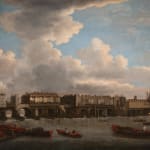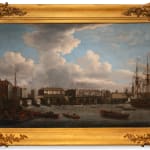John Cleveley Snr British, c. 1712-1777
34 x 44¾ in. (86.5 x 113.6 cm) framed
Provenance
Sotheby's, London, 7th July, 2022, lot 196.Old London Bridge was an iconic feature of London for over 600 years and until Westminster Bridge opened in 1750, was the only crossing point over the Thames. Replacing a succession of timber bridges, the impressive stone structure took over 30 years to build and was completed in 1209. 282 metres long and 40 feet wide, the bridge stood 60 feet above the water level and consisted of 19 irregularly spaced piers and arches of varying widths. Its longevity was testament to its design and construction but inevitably fires, rebellions, decay, architectural innovations and an evolving city all contributed to extensive alterations and a changing appearance over the centuries.
The bridge functioned beyond transporting people, goods and livestock across the river. It was a place of trade and commerce and home to hundreds of people, many of whom who worked in shop houses benefitting from the passing traffic. At its southern end, it was protected by the Great Stone Gate which had a portcullis and nearer the centre, a drawbridge added further protection as well as allowing taller ships to pass through. A medieval chapel dedicated to Thomas Becket was built for travellers to worship and marked the start and end point for pilgrimages to and from Canterbury. The bridge was also used as a ceremonial procession route. Rents were collected to lease buildings and tolls charged for carts to cross and boats to pass under the drawbridge, all to provide revenue for the upkeep of the bridge.
This painting by John Cleveley the elder (c.1712-1777) is based on the work by Samuel Scott (c.1702-1772), A View of London Bridge before the Late Alterations, now in the Tate collection, which was engraved by Pierre Charles Canot (1710-1777) in 1758. The scene depicts the bridge shortly before work began in 1757 to remove its buildings, in order to widen the bridge and ease congestion which had become dangerous. Whilst it was widely accepted the bridge needed updating, there remained a great nostalgia for the historic landmark, which was likely the inspiration for Cleveley, or someone commissioning him, to record it. This painting serves as an historical document, recording the bridge’s unique architectural splendour, before its gradual demolition and eventual replacement in the nineteenth century.
The view in the painting looks upstream from the South Bank towards the east side of the bridge and across to the City of London. Everyday activity takes place on the river; a large ship is docked to the right and repairs are being made to a pier beyond. Various boats transport people and goods. To the left, men draw in a fabric from the water and a vessel bearing a Dutch flag sits behind. Visible through the arches on the left is the damming effect of the bridge, which created a drop in the water level of up to six feet and treacherous rapids for river traffic to navigate. Tracing from left to right, various buildings on the bridge can be identified; a group of houses rebuilt following a major fire in 1725; the Great Stone Gate - originally built in the thirteenth century with a drawbridge and portcullis but also rebuilt after the fire of 1725. In earlier years the gate displayed the heads of traitors on spikes; a group of houses with railed roof gardens, rebuilt in the seventeenth century; the drawbridge - once regularly used to allow larger vessels to pass through but permanently fixed in 1722; Nonsuch House - an elaborately decorated four-storey building prefabricated in Holland before being shipped to London and reconstructed on the bridge in place of the old Drawbridge Gate in 1577. By the time of this scene it was in a state of disrepair; a group of seventeenth-century houses known as ‘The Middle’ with railed roof gardens; the remains of the Chapel of St Thomas - an original feature of the bridge built on the largest pier specifically designed to house a chapel. It was dissolved as a place of worship during the Reformation in 1548 and partially demolished. It later became known as Chapel House and from 1751 was the premises of the stationers Wright & Gill; lastly, the most recent buildings on the bridge designed by George Dance the Elder (1695-1768) and built in 1745. To the far right, rising above the City, are the Christopher Wren church spires of St Michael, Crooked Lane and St Magnus the Martyr, as well as the notable landmark the Monument.
John Cleveley was a leading maritime painter of the eighteenth century, known for his historically important records of ship building and launches at Deptford, naval engagements and fleet reviews. Born in Southwark, he was the son of a joiner and in his early teenage years apprenticed as a joiner and to a Deptford-based shipwright John Hall. In 1743 he became a freeman of the Shipwrights’ Company and began a career as a shipwright in the Royal Dockyard, Deptford. This provided him with the deep understanding and knowledge of ships translated in his painting and whilst little is known about his artistic training, it is thought he could have been taught to paint by ship painters based in the dockyard. He exhibited at the Free Society of Artists in London as well as at the Royal Academy from 1770. Despite his talent and success as a painter, it appears he remained attached to the dockyard. The year after his death in 1778, he is mentioned in an administration order as a ‘carpenter, belonging to His Majesty’s ship Victory (later of Nelson fame) in the pay of His Mjs Navy’. Two of his three sons, John Cleveley the Younger and his twin brother, Robert Cleveley also became painters after working in Deptford's Royal Dockyard. Examples by Cleveley can be found in various notable collections, including the National Maritime Museum and Yale Center for British Art. His painting Deptford Shipyard, London (1755) sold for $300,000 (hammer) at Sotheby’s New York on 1st February, 2018, lot 74.



